Tags
To Americans, whose interests in things outside our borders is close to nil, Buddhism is an exotic and rather strange religion. Most are familiar with the Dalai Lama, or at least the idea of the Dalai Lama, know Buddhists don’t kill bugs, and have a muddled knowledge involving Richard Gere and the religion, though whether his religious beliefs have anything to do with his fondness of gerbils is anyone’s call. Few realize that there is more than one branch of Buddhism, just as there are with the other major religions of the world, and that the type of Buddhism practiced in Tibet – the one most Americans have at least minimal knowledge of – has little to do with that practiced in most of SE Asia. That makes Bangkok’s Erawan shrine a fitting introduction to Buddhism in Thailand for visitors from the States, since it is a Hindu, not Buddhist, shrine and the current statue that is the shrine’s focal point is a replacement for the one that originally brought the shrine its fame and glory.
Smack dab in the middle of Thailand’s capital city’s premier shopping district, the Erawan Shrine is passed by thousands of tourists every day either zipping above on the Skytrain or plodding along stuck in the town’s notorious traffic jams. Those traveling on the former may not realize they have just passed one of Bangkok’s most famous religious sites, other than to note how many fellow passengers just turned and let loose with a reverent wai. Those enjoying the air-conditioned comfort of a taxi too may not notice the small shrine, other than to note the crowds or the bank of smoke drifting outwards from its corner location (though they too may take note their driver just turned to wai, completely ignoring the job he is supposed to be doing: driving).
Many wander in attracted by the scene, often as a break from scurrying from one massive shopping mall to the next. Others make a beeline for the place following the recommendation of a guide book and its section on the four-headed Buddha, proving GIGO was alive and well even before the internet came along. Fortunately the shrine does not rely on clueless visitors, there are plenty who come to Erawan daily for what the shrine is really all about. And that’s money, wealth, and good fortune.
Another error unsuspecting visitors make is to take the small open-aired shrine in with a quick glance. Spend a bit more time to see what is really going on there and you’ll be rewarded with the sight of a Thai classic dance troupe, merit makers bringing in bags full of offerings of statues and floral arrangements, and attendants whisking away tributes left – in what sometimes is but a matter of minutes – deposited straight into a trash can with a studied nonchalance that would make the reverent blanch if it were not for the logic of the procedure; the shrine is so popular it would be buried in a mass of flowers if not constantly attended to.
There is also the sight of those who are obvious working girls asking for the gods to favor them, a small basin where devotees anoint themselves in a fashion that would be familiar to Catholics, gaggles of local kids with their mom or dad as bored with the proceedings as any youngster attending church on Sunday back in the States, and flocks of small birds being released from their red wood cages by those who’ve paid to make merit by their flight. It is a bustling, vibrant, heady scene, with a McDonald’s conveniently located just a few steps away. And it is all thanks to the Thai government’s decision to build a luxury hotel in downtown Bangkok back in 1953.
Even though a ceremony was held to appease the land deity where the Erawan Hotel was to be built, early construction was plagued by delays and mishaps, including cost overruns, injuries, and the loss of a shipload of Italian marble intended for use in the construction, which spooked the superstitious Thai construction workers to the point of calling a work stoppage. In desperation, a well-respected astrologer was consulted, who discovered the foundation stone for the building had not been laid on an auspicious date.
The erection of a shrine to honor the four-faced Brahma God, Than Tao Mahaprom, was considered to be the ticket to reversing the tide of misfortune that had been plaguing the construction site, and a magnificent image of the Brahma god was cast, gilded, and then inaugurated on November 9, 1956, a date carefully chosen this time around. Once it was in place, hotel construction proceeded without further difficulty, the shrine earned a reputation as a place to pray for good fortune, and for more than thirty years Thais and foreigners, particularly tourists from SE Asia, Taiwan, and Hong Kong flocked to the shrine to seek the blessings of Brahma.
By the 1990s, the once regal hotel could no longer compete with its newer 5 star neighbors and was rebuilt by the Hyatt hotel corporation, who wisely retained the famous shrine and kept its common name as part of the new hotel. That hotel too prospered and thousands of the faithful and the hopeful continued to pay homage at Erawan until the spring of 2006 when 27-year-old Thanakorn Pakdeepol, a Thai man believed to be mentally ill, took a hammer to the statue of Brahma early one morning, smashing the god to bits, leaving only part of the lap and base of the statue intact.
Though Than Tao Mahaprom is a Brahma god, full of kindness, mercy, and sympathy, his virtues were ignored by two street sweepers working nearby who witnessed the act of vandalism and promptly beat Thanakorn to death.
The shrine was closed to the public for two days before reopening with a white cloth draping the remains of the statue; photographs were put on display so that worshippers could continue to pay their respects. A new statue was cast, replacing the original one made of plaster and plated in gold with one made of metal, and two months later (undoubtedly on an auspicious date) the new four-faced Brahma was installed in a lavish ceremony that was televised live and which drew devotees from all over SE Asia including a special charter flight from Hong Kong.
Located at the Ratchaprasong intersection of Rachadamri and Ploenchit Roads, and at the foot of the Chit Lom BTS station, the Erawan Shrine continues to be one of the most heavily visited places of worship in Bangkok. It is a place to make wishes, and whether you are a Buddhist praying at a Hindu shrine, or a visitor, your best bet to have the gods look favorably on your plea is to first bribe them show them proper respect through an offering. Most do so at Erawan by purchasing incense sticks to burn and flower garlands to drape on the shrine. Others bring their own offerings, some quite elaborate and pricey. There are also caged birds to free, and many hire the traditional Thai dance troupe who work the shrine to perform while they say their prayers.
The dancers work eight hour shifts every other day and earn 19 baht per performance, which averages a take-home pay of about 1,000 baht per day. Worshipers can hire the dancers in clusters of two, four, six or eight to perform and sing a prayer with price ranges running from 260 to 710 baht. Visitors can watch the performances for free, and the haunting xylophone music backed by the beating of a double-sided drum provide a captivating soundtrack to the shrine’s activities.
One of the most easily accessible spots in Bangkok to take in some local religious culture, the Erawan Shrine is open daily from 6:00 a.m. to 11:00 p.m. and admission is free. Cash contributions are managed by a foundation who distributes funds to various charitable organizations and purchases equipment for needy hospitals in the country’s rural areas. Visitors from the U.S. who don’t make the time to for a quick pilgrimage to Erawan can instead visit the reproduction installed at Caesars Palace in Las Vegas where like the Buddhists of Thailand, Christians too stop to say a quick prayer to a Hindu god in the hopes of enticing some good fortune their way.
Related Posts You Might Enjoy:



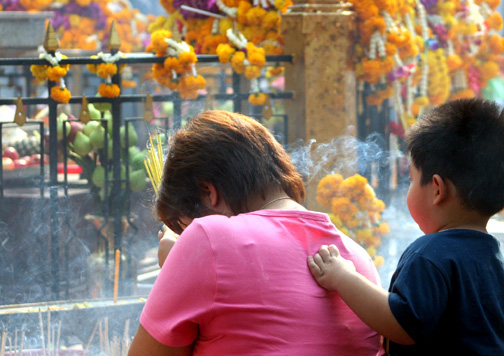


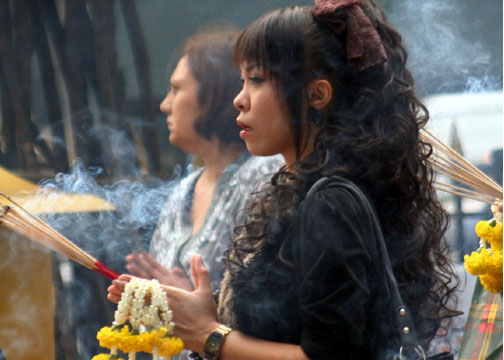
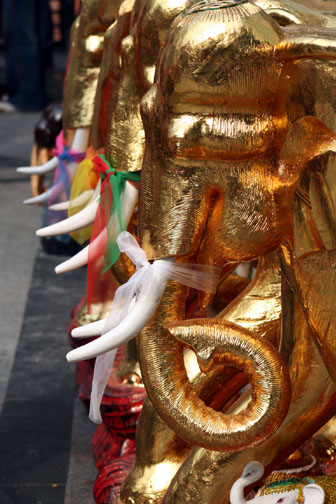
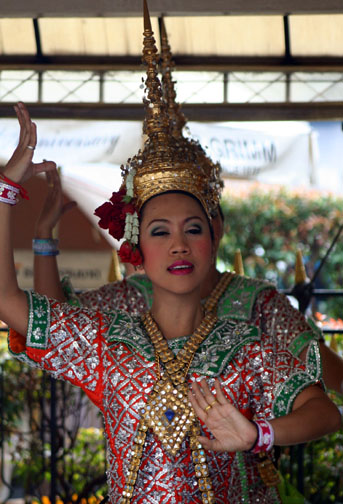
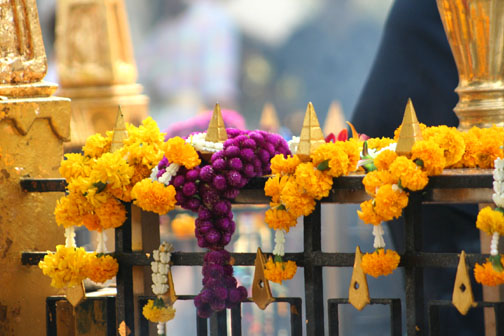

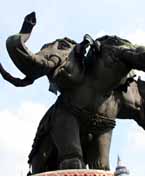

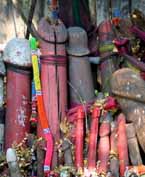
I try to pray at this shrine first thing on arrival every time I come to Bangkok. I confess my sins and hope for absolution (and then I go out and start accumulating a whole new batch for next time) but the funny thing is that in spit of its popularity, there are still cab drivers who don’t seem to know how to get to it – but telling them Erawan Hotel gets me there without any delay every time. Curious, isn’t it?
Are you sure you are not catholic XD?
Only if he’s well hung, good looking and willing. For that, I’d be Bongopanu if he wanted.
Enough of this anti-Catholic talk, Catholics are ok, I have personally annointed a few of them in my day ( good for the skin one told me ) Catholic boys schools were very ‘in’ when I was but a lad. Father Jakov was my favourite tutor.
Anyway, there is a shrine you probably know but I don’t know the name of it, it’s built on the footpath outside a dept. store at the MRT end on MBK. A tryst with a rather charming freelancer brings fond memories of the shrine. Not so the unending parade of touts telling me the shop I just left is closed, oh really…
Would you happen to remember or know the name of that shrine, it’s clearly visible from the bridge from MBK to the MRT station. Always has people making merit.
Great story again by the way, I love how your stories bring back great memories. When I finally get my damned knee replacement in December I may well be due for a visit again to the City of Angels.
I don’t know that shrine Al, but then anytime I’m near a mall Noom is hustling me forward to make an offering to the gods of consumerism. Maybe another reader does and will fill us in.
Um, you know you could sit on the edge of the bed – you don’t need your knees to work for a visit to Bangkok.
Ahhh yes but I need the knees to find a vict,,,err friend, unless they come through room service now. Now there’s an idea. Something like ‘flirt for free’ (web site) on your room TV and make your selection……hmmmm. I wanna be fighting fit when I get back there. Been a while, taking no prisoners lol.
lol
Bangkok dangerous will take on a whole new meaning . . .
I think America’s “understanding” of Buddhism has been greatly enhanced by the recent announcement from the Dhammakaya group in Thailand that “Steve Jobs has been re-incarnated as a celestial warrior-philosopher living in a mystical glass palace hovering above his old office at Apple’s headquarters”!
This was widely covered in the tech and regular press but somehow I think Fox News is the most “appropriate” source to quote from!
http://www.foxnews.com/tech/2012/08/31/steve-jobs-has-been-reincarnated-as-warrior-philosopher-thai-group-says/
bkkguy
God I love FOX!
But that’s cool, at least that means Jobs doesn’t have a grave to be rolling over in everytime the rebublicans try to claim him as their own.
Thanks for the link, I’d missed that.
Great post! An ex-boyfriend’s younger brother once made good use of this shrine to avoid being conscripted. It worked like this: On the day before the draft, he went to the shrine to make an initial offering and to let the God know his wish, at the same time promising that he’d return with a much larger offering in case his wish was granted. He wasn’t drafted, naturally credited his deal with the deity for his good fortune and returned as promised.
The idea that he was rather bribing the spirit than praying crossed my mind as well. But the important thing is that it worked.
The largest mass of offering I ever saw at Erawan was an old guy who had half a dozen garbage bags filled with goodies. He had a retinue help him haul them to the entrance, but then felt he had to carry each himself into the shrine where the attendants helped him place all of the stuff around the god. I asked Noom about it and his reply was, “He get what he want, now pay for it.”
So I guess the after-the-fact offering is common. So practical!
I’ll have you know bribing the spirits, the gods and our ancestors is a time-honoured way of making merit (and getting what you want) in Asia. Asians offer alcohol, food and other sacrifices to all of the above regularly but we Chinese are probably guilty of offering money directly (and Mercedes, Rolls-Royces, Ipads, Iphones, gold, silver, and jewellery) – and convincing all the other Asians to follow suit – but of course, we’re much too smart to burn the real thing. We invented paper, didn’t we?